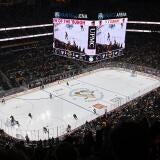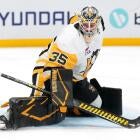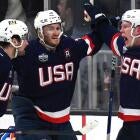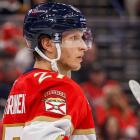
The Maple Leafs front office is finally giving their fans some hope
Thanks to the leadership of Brendan Shanahan in the front office and Mike Babcock behind the bench, Toronto Maple Leafs fans should have something they haven't had for a while: hope for the future of the team.

The Toronto Maple Leafs are probably not going to be a very good hockey team this season.
They weren't one last season, and with only one playoff appearance (in a lockout shortened season) since 2004 they really haven't been one in more than a decade. But for the first time in quite a while they seem to have a real long-term outlook, as well as the right people in place in the right positions of power that might be able to turn around one of the NHL's most iconic franchises and return it to relevance after years as a league punchline.
They have already made two major moves this offseason by bringing in Mike Babcock to coach the NHL team, and then trading the best player on the roster -- Phil Kessel -- for a collection of prospects and more draft picks.
What should be most encouraging for Maple Leafs fans is the approach the new front office under the leadership of Brendan Shanahan has taken when it comes to rebuilding the team. Not only is there now a core of promising young prospects they can build around (Morgan Reilly, William Nylander, Kasperi Kapenen, Mitch Marner), everything the team has done the past two seasons is about maximizing the return on assets they already have and assets they acquire.
There is no foolish spending taking place in free agency. They are not giving up draft picks to acquire marginal players that will have little short-term or long-term impact on the well being of the team. They are not re-signing players to long-term, big-money contracts that have little chance of ever being a key part of a contending team in Toronto.
They have an actual eye toward the future instead of throwing mountains of cash at mediocrity in an effort to just sneak into the playoffs, or to go from being really bad to just kind of bad. They are going out of their way to do whatever it takes to get more draft picks in their possession. They are then using those picks to draft players that are highly skilled no matter how big or small they might be physically. They are signing bargain bin free agents to short-term, low-money deals that they can build up and flip for more assets after a few months.
When it comes to NHL free agency there are basically three different kinds of players teams find on the open market.
You have the top-line player that is still probably in the prime of his career for another couple of years before starting to fade. These players are becoming increasingly rare on the free-agent market and you probably have to go back to Zach Parise and Ryan Suter back in the summer of 2012 to find the last time there was such a player available.
That leaves teams with the dreaded mid-level player, one that is very good and useful in the right role, but also one that is likely to get paid too much for what they provide. Also included in this group: The player coming off of a career year that will never be duplicated at just the right time and cashes in on it. This is where teams -- and especially the Maple Leafs in the past -- get into trouble, even if there were not many obvious mistakes this summer.
And then you have the bargain bin. Players that are coming off of down years that crushed their value. Players that maybe had a bad postseason that soured teams on them. Or players that, for one reason or another, are just simply undervalued because they're undersized, not tough enough, or aren't talented enough to be a top-line player but don't fit what many tems look for in third-or fourth-line role.
It's the latter group that can prove to be the best use of free agency for teams. Contenders that are pushed to the limits of the salary cap can find cheap role players or players that are due for a bounceback season. The Toronto Maple Leafs seem to use them for a different reason: to fill out an NHL roster for a few months and then flip them for draft picks at the deadline.
Over the first week of the free-agent signing period the Maple Leafs have signed forwards Daniel Winnik, P.A. Parenteau, Mark Arcobello and Shawn Matthias, as well as defenseman Matt Hunwick, to short-term contracts that will cost the team just a little more than $9 million against the salary cap this upcoming season. All of these guys are pretty useful. Parenteau averages about 18 goals per 82 games in the NHL, Acrobello is coming off of a 17-goal season that he split between five different teams and Winnik is a strong defensive forward and penalty killer. They are not enough to make the Maple Leafs a good team, but can they still serve a purpose as trade bait, just as they did last season with the bargain signings of Winnik and Mike Santorelli.
Ryan Lambert recently did a great job breaking down all of the contributions Toronto was able to get from those players and how they were able to sell them to contenders for more assets, including an NHL defenseman and four draft picks, three of which were among the first 70 picks in a deep 2015 draft and a future pick next season.
Compare all of this to the approach the team had taken in recent years under the previous management -- especially what turned out to be the disastrous 2013 offseason -- that saw the team trade assets (two draft picks) for one year of Dave Bolland, sign David Clarkson to one of the worst free-agent contracts in recent history, and lose several valuable, productive players in Clarke MacArthur, Mikhail Grabovski and Nikolai Kulemin for nothing after misusing them when they were a part of the team.
Just consider the assets the Maple Leafs received for MacArthur, Grabovski and Kulemin, all of whom spent the 2014-15 season as contributors to playoff teams and, when used properly, were extremely productive in Toronto (Grabovski and MacArthur both averaged 50 points per 82 games played during their time in Toronto -- that is second-line, and borderline first-line production in the current NHL goal scoring climate): *crickets chirping*
No, I didn't forget to list any names. They simply didn't get anything in return for them. Not one draft pick. Not one prospect. Not one player that could have been an asset to the NHL roster.
Nothing.
And that was after they did everything possible to minimize the impact those players could have possibly made on the roster. MacArthur, who was one of the most productive players on the team when he was in the lineup and scored two goals in the 2012-13 playoff series against Boston, was given only 12 minutes of ice time per game in that series and was a healthy scratch twice. He went unsigned as a free agent after the season and signed on with Ottawa (for a very reasonable amount of money), where he has outscored just about every forward the Maple Leafs had under contract the past two years.
Grabvoski and Kulemin were skilled forwards that had been 50-point players in the NHL and were relegated to checking-line, defensive roles, severely limiting what they could do offensively. Grabovski was bought out so the team could sign Clarkson (who never came close to matching Grabovski's production before he was dumped in a clever cap-clearing deal at the 2015 trade deadline) and re-sign Tyler Bozak. Kulemin played one more year before leaving as a free agent.
These are the mistakes that add up into big mistakes that end up costing a team its future. You just can't lose assets like that for nothing when you're also trading more assets for players like Bolland and Ryan O'Byrne. It's how a team like Toronto ends up having only 17 draft picks between 2012 and 2014, including only six in the first three rounds of the draft. They had five picks in the first three rounds in 2015 alone, and already have five in the first three rounds of the 2016 draft and the potential to add even more.
Those mistakes are not happening anymore.
Now compare what they were able to get out of Winnik and Santorelli (none of whom are as good as MacArthur, Grabovski or Kulemin) and the remainder of Franson's contract. Remember, all of these players are currently in the organization and will be for some time: Martin Marincin, Brendan Leipsic, Travis Dermott (No. 34 pick in 2015), Jeremy Bracco (No. 61 pick in 2015), Martins Dzierkals (No. 68 pick in 2015) and a 2016 sixth-round draft pick. That's one young NHL defenseman that still has some upside, four very good prospects, including Leipsic who put up some huge numbers during his junior hockey days and recorded 54 points in 74 games in the AHL during his first year of pro hockey, and another future draft pick.
All of that for two guys that were signed to one-year, bargain contracts and a defenseman they were going to lose for nothing.
It's a complete 180 in terms of the approach and the execution the approach.
Not all of these prospects and draft picks are going to pan out and be something useful in the NHL. Many of them will never reach the NHL at all, and some of the ones that do will not be impact players. And that's OK because it's just the nature of the beast that is the NHL draft. Most of the players picked aren't going to make the league.
But out of all of those draft picks, and all of those prospects that have been added to the organization, they are going to find somebody (perhaps more than one. Maybe more than two) that is going to make an impact for them and be a part of a contending team in the very near future.
And that is something the Maple Leafs might finally be building.

















